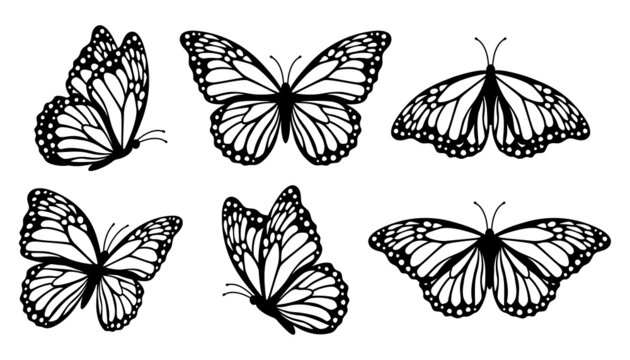
Butterflies have long captivated artists and nature lovers alike with their vibrant colors, delicate forms, and symbolic meanings. This article delves into the enchanting world of butterfly drawing, offering detailed techniques, helpful tips, and creative inspiration to elevate your artistic endeavors.
Understanding the Anatomy of Butterflies
Before embarking on your butterfly drawing journey, it is essential to familiarize yourself with the anatomy of butterflies. Understanding their structure not only enhances your observational skills but also contributes to the overall realism of your artwork.
Key Parts of a Butterfly
- Wings: Butterflies are renowned for their asymmetrical wings, each displaying intricate patterns and colors. The upper side often showcases vibrant hues, while the underside features muted tones that provide camouflage.
- Body: The butterfly’s body consists of three main sections: the head, thorax, and abdomen. Each section plays a crucial role in the butterfly’s overall appearance.
- Antennae: These slender, elongated structures are crucial for sensory perception, helping butterflies navigate their environment.
- Legs: Butterflies have six legs, typically featuring fine hairs that assist in gripping surfaces, particularly while feeding on nectar.
Materials for Butterfly Drawing
Choosing the right materials can significantly impact your butterfly drawing experience. Here’s a list of essential tools to consider:
Pencils
- Graphite Pencils: For sketching and adding depth, a range of graphite pencils (HB, 2B, 4B) will provide the necessary contrast and detail.
- Colored Pencils: High-quality colored pencils allow for vibrant color application and blending.
Paper
- Sketch Paper: Ideal for practice sketches and preliminary drawings.
- Bristol Board: Smooth and durable, this paper is perfect for final pieces, especially when using colored pencils.
Erasers
- Kneaded Eraser: Excellent for lifting graphite without damaging the paper.
- Vinyl Eraser: Useful for clean corrections.
Additional Tools
- Blending Stumps: For smoothing and blending colored pencil work.
- Fine-liner Pens: For adding details and outlines after the initial sketch is complete.
Techniques for Captivating Butterfly Drawings
1. Observation and Reference
Before you begin drawing, spend time observing real butterflies or high-quality photographs. Pay attention to their color patterns, shapes, and the way light interacts with their wings. Using reference images can guide your drawing and help achieve accuracy.
2. Sketching the Outline
Start by lightly sketching the basic shape of the butterfly. Focus on:
- Symmetry: Ensure that both wings mirror each other in shape and size.
- Proportions: Maintain accurate proportions between the wings, body, and antennae.
3. Adding Details
Once the outline is complete, begin adding intricate details:
- Wing Patterns: Observe the unique patterns on the wings and replicate them. Use light strokes to map out shapes before committing with darker lines.
- Texturing: Incorporate texture into the wings to mimic the scales found on butterfly wings. Use short, curved lines to depict this effect.
4. Color Application
When applying color, consider the following techniques:
- Layering: Build up colors gradually by layering light hues before adding darker shades. This creates depth and richness in your artwork.
- Blending: Use blending stumps or your fingers to smooth transitions between colors, enhancing the realism of the wings.
- Highlights and Shadows: Add highlights using lighter colors and create shadows with darker tones to give your drawing a three-dimensional appearance.
5. Final Touches
After coloring, revisit the outlines with a fine-liner pen to define the edges and add depth. Small touches, like enhancing the antennae or adding a subtle background, can elevate your butterfly drawing further.
Finding Inspiration for Your Butterfly Drawings
Nature and Environment
Nature offers endless inspiration for butterfly drawings. Visit gardens, parks, or butterfly conservatories to observe various species in their natural habitats. Take photographs or make sketches of butterflies in different poses to serve as future references.
Artistic Styles
Explore different artistic styles to infuse creativity into your butterfly drawings:
- Realism: Focus on accurately portraying the butterfly with attention to detail.
- Abstract: Experiment with colors and shapes that evoke the essence of butterflies without strict adherence to realism.
- Whimsical: Incorporate playful elements and imaginative backgrounds to create a lighthearted atmosphere.
Online Resources and Communities
Join online art communities, forums, or social media groups dedicated to drawing and butterflies. Share your work, receive feedback, and discover new techniques and styles from fellow artists.
Common Mistakes to Avoid
While creating butterfly drawings, keep an eye out for common pitfalls:
- Neglecting Symmetry: Pay careful attention to the balance between both wings. Asymmetry is common in nature, but the basic shape should be consistent.
- Overcomplicating Patterns: Start with simple patterns before adding complexity. Focus on accuracy before detailing.
- Ignoring Light Sources: Consider the direction of light when shading and highlighting to create a more lifelike appearance.
Showcasing Your Artwork
Once you have completed your butterfly drawing, consider showcasing it. There are numerous avenues for sharing your work:
Social Media Platforms
Platforms like Instagram and Pinterest are excellent for sharing your butterfly drawings with a broader audience. Use relevant hashtags like #ButterflyArt, #Drawing, and #NatureArt to increase visibility.
Art Exhibitions and Competitions
Participating in local art exhibitions or online competitions can provide exposure and recognition for your work. Look for opportunities that focus on nature or themed art events.
The Joy of Butterfly Drawing
Drawing butterflies is not merely an artistic endeavor; it is an exploration of nature’s beauty and a testament to creativity. By understanding butterfly anatomy, mastering drawing techniques, and finding inspiration in the world around us, we can create stunning artworks that resonate with viewers.
With patience and practice, each butterfly drawing becomes a unique expression of art, capturing the grace and elegance of these magnificent creatures. So, gather your materials, unleash your creativity, and let the world of butterfly drawing take flight!